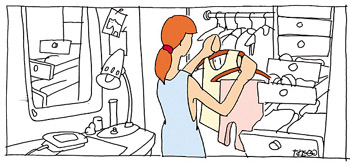Spoiled by Choice
|
|
Imagine a happy couch potato lounging around with a large box of popcorn, a couple of beers, and a wide screen TV connected to cable and satellite. He may find himself in something of a dilemma. Having a choice of 500 channels, how does he select the program that he wants to watch? A traditional paper-based TV Guide is far too unwieldy and probably out of date. So he has three choices:
-
To watch what he normally watches. It’s 7:45 p.m., so that means “Friends.”
-
To go channel hopping. If we assume 3 seconds per channel, in this case it will take 25 minutes to surf through them all. Supposing that the program he decides to watch was somewhere around channel 450, he will have missed the show, anyway.

Scenario sketches drawn in a project aiming at concepts for short distance wireless communication. (Keinonen 2000.)
-
To use the electronic program guide. Even on a wide-screen TV, this display can only show a small percentage of what is available. Therefore the guide can be made intelligent enough to support a search feature—this couch potato wants to watch an action film. The latest electronic program guides have progressed to suggesting what viewers might like to watch on the basis of their TV watching profile, whether determined automatically or based on a questionnaire.
This degree of complexity is just about to hit mobile phones. The person in the street will soon have something in common with the overburdened TV viewer, except that the screen of this individual’s handheld unit is considerably smaller. We can already say with some assurance that 200 items in the hierarchical menu of the Nokia 3310 is too much for easy and efficient navigation. Still, the phone doesn’t even include a browser of any kind—WAP or Web—as its successor Nokia 3330 does. Let’s do another quick exercise. What will happen when all the information in the Internet is available through mobile phones? Typing the search term “mobile phone” in AltaVista (www.altavista.com) results in 727,822 hits [June 20, 2001 at around 15:00 GMT (3:00 p.m. Greenwich mean time)]. If we were to perform the search on a mobile phone, the browser would display 727,822 items in one list or in a hierarchical tree to the user. At that point, designers would face a problem of a new magnitude. The hierarchical menu structure that has been appropriate so far would collapse. Would it be simply impossible to access a large amount of information, such as those the Internet delivers, through a small mobile device?
|
|
EAN: 2147483647
Pages: 142